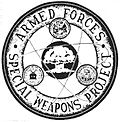
Back مشروع الأسلحة الخاصة للقوات المسلحة Arabic Proyecto de Armas Especiales para las Fuerzas Armadas Spanish Armed Forces Special Weapons Project French सशस्त्र बल विशेष हथियार परियोजना Hindi
| Armed Forces Special Weapons Project | |
|---|---|
 Armed Forces Special Weapons Project patch | |
| Active | 1 January 1947 – 6 May 1959 |
| Country | |
| Garrison/HQ | Washington, D.C.[1] |
| Commanders | |
| Notable commanders | Leslie Groves Kenneth Nichols Herbert Loper Alvin Luedecke |
| Insignia | |
| Seal |  |
The Armed Forces Special Weapons Project (AFSWP) was a United States military agency responsible for those aspects of nuclear weapons remaining under military control after the Manhattan Project was succeeded by the Atomic Energy Commission on 1 January 1947. These responsibilities included the maintenance, storage, surveillance, security and handling of nuclear weapons, as well as supporting nuclear testing. The AFSWP was a joint organization, staffed by the United States Army, United States Navy and United States Air Force; its chief was supported by deputies from the other two services. Major General Leslie R. Groves, the former head of the Manhattan Project, was its first chief.
The early nuclear weapons were large, complex, and cumbersome. They were stored as components rather than complete devices and required expert knowledge to assemble. The short life of their lead-acid batteries and modulated neutron initiators, and the heat generated by the fissile cores, precluded storing them assembled. The large quantity of conventional explosive in each weapon demanded special care be taken in handling. Groves hand-picked a team of regular Army officers, who were trained in the assembly and handling of the weapons. They in turn trained the enlisted soldiers, and the Army teams then trained teams from the Navy and Air Force.
As nuclear weapons development proceeded, the weapons became mass-produced, smaller, lighter, and easier to store, handle, and maintain. They also required less effort to assemble. The AFSWP gradually shifted its emphasis away from training assembly teams, and became more involved in stockpile management and providing administrative, technical, and logistical support. It supported nuclear weapons testing, although after Operation Sandstone in 1948, this was increasingly in a planning and training capacity rather than a field role. In 1959, the AFSWP became the Defense Atomic Support Agency (DASA), a field agency of the Department of Defense.
- ^ Borg, D. C. (May 1954). "Report AFSWP-507: Radioactive Fallout Hazards from Surface Bursts of Very High Yield Nuclear Weapons" (PDF). U.S. Armed Forces Special Weapons Project. Retrieved 10 December 2022.